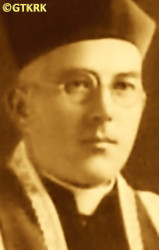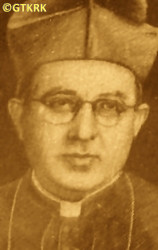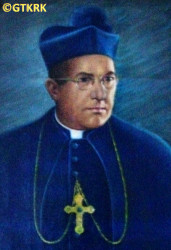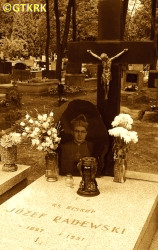Roman Catholic
St Sigismund parish
05-507 Słomczyn
85 Wiślana Str.
Konstancin deanery
Warsaw archdiocese, Poland
full list:
displayClick to display full list

searchClick to search full list by categories
wyświetlKliknij by wyświetlić pełną listę po polsku

szukajKliknij by przeszukać listę wg kategorii po polsku

Martyrology of the clergy — Poland
XX century (1914 – 1989)
personal data
surname
PADEWSKI
surname
versions/aliases
PODESZWA
forename(s)
Joseph (pl. Józef)
function
bishop
creed
Polish National Catholic Church PNCCmore on
en.wikipedia.org
[access: 2023.11.24]
date and place
of death
10.05.1951

Warsawtoday: Warsaw city pov., Masovia voiv., Poland
more on
en.wikipedia.org
[access: 2021.10.09]
details of death
During World War II started by German and Russian invasion of Poland in 09.1939, during German occupation, arrested by the German in 09.1942 in Germ. Generalgouvernement (Eng. General Governorate).
Held in Montelupich Str. prison in Kraków.
From there transported to the subcamp Germ. Internierungslager (Eng. Internment camp) Ilag VII/Z at the castle in Tittmoning in Bavaria, Germany, where most of the prisoners came from occupied Poland and had American passports.
There released thanks to Swiss Red Cross intervention and as a party to the prisoner exchange found himself in Switzerland.
From there went to USA.
On 20.02.1946 returned to Poland, then already under Russian occupation.
On 07.01.1951 in Kraków apprehended by the Commie‐Nazi UB police, branch of Russian MGB.
Held under home arrest.
Accused of illegal trading in currency — but in reality in retribution for an escape of one of his priest to the West and deposition he made about «Katyn genocide» perpetrated by the Russians.
On 08.02.1951 transported to Warsaw.
Held in Rakowiecka Str. prison in Warsaw.
After the interrogation on 28.03.1951, was supposedly taken back to his cell with broken glasses and a broken crown in his jaw.
Did not admit guilt, nor refused to place blame any of his collaborators.
There prob. tortured to death by UB functionaries.
The autopsy was supposed to show however that died „due to post–operative complications”, which underwent in late 1950.
cause of death
murder
perpetrators
Russians / Poles
sites and events
Warsaw (Mokotów)Click to display the description, Cracow (Montelupich)Click to display the description, GeneralgouvernementClick to display the description, Ribbentrop‐MolotovClick to display the description
date and place
of birth
18.02.1894

Antoniówtoday: Ciepielów gm., Lipsko pov., Masovia voiv., Poland
more on
en.wikipedia.org
[access: 2022.08.28]
alt. dates and places
of birth
19.03.1894
parents
PODESZWA Adalbert
🞲 ?, ? — 🕆 ?, ?

BERNAŚ Mary
🞲 ?, ? — 🕆 ?, ?
presbyter (holy orders)
ordination
16.12.1919

positions held
1936 – 1951
bishop — Polish PNCC missionary diocese
26.08.1936
Bishop — Scrantontoday: Lackawanna Cou., Pennsylvania US‐PA state, United States of America
more on
en.wikipedia.org
[access: 2024.03.17] ⋄ PNCC Church — Bishop's ordination; election: in 1935, 2nd PNCC Synod
from 01.1933
administrator — Polish PNCC missionary diocese — also: chairman of the Church Council in Poland
1931 – 1933
assistant — PNCC Church — assistant to Bp Leo Grochowski
16.12.1919
priest — PNCC Church — ordination
1916 – 1919
student — Scrantontoday: Lackawanna Cou., Pennsylvania US‐PA state, United States of America
more on
en.wikipedia.org
[access: 2024.03.17] ⋄ philosophy and theology, Girolamo Savonarola's PNCC Theological Seminary
others related
in death
BRZOZOWSKIClick to display biography Stanislav Kostka, PRZASTEKClick to display biography Henry Francis
sites and events
descriptions
Warsaw (Mokotów): Prison and detention centre in Warsaw on Rakowiecka Str. Used by Germans during German occupation 1939‐1945 to held thousands of Poles. In 1945‐1956 thousands of Polish independence activists were held there by the Polish Commie‐Nazi branch of Russian NKVD/KGB police. Hundreds of Poles were executed. (more on: pl.wikipedia.orgClick to attempt to display webpage
[access: 2013.08.17])
Cracow (Montelupich): Cracow penal prison, during occupation run by the Germans — from 28.02.1941 by Germ. Geheime Staatspolizei (Eng. Secret State Police, known as Gestapo. In 1940‐1944 Germans jailed there approx. 50,000 prisoners, mainly Poles and Jews. Some of them were transported to KL Auschwitz concentration camp, some were executed. After cease in war effort the prison was used by UB — a Polish unit of Russian NKVD — as a prison for Polish independence resistance fighters, some of which were subsequently sent to prisons and slave labour camps in Russia. (more on: en.wikipedia.orgClick to attempt to display webpage
[access: 2014.10.31])
Generalgouvernement: After the Polish defeat in the 09.1939 campaign, which was the result of the Ribbentrop‐Molotov Pact and constituted the first stage of World War II, and the beginning of German occupation in part of Poland (in the other, eastern part of Poland, the Russian occupation began), the Germans divided the occupied Polish territory into five main regions. In two of them new German provinces were created, two other were incorporated into other provinces. However, the fifth part was treated separately, and in a political sense it was supposed to recreate the German idea from 1915 (during World War I, after the defeat of the Russians in the Battle of Gorlice in 05.1915) of creating a Polish enclave within Germany. Illegal in the sense of international law, i.e. Hague Convention, and public law, managed by the Germans according to separate laws — especially established for the Polish Germ. Untermenschen (Eng. subhumans) — till the Russian offensive in 1945 it constituted part of the Germ. Großdeutschland (Eng. Greater Germany). Till 31.07.1940 formally called Germ. Generalgouvernement für die besetzten polnischen Gebiete (Eng. General Government for the occupied Polish lands) — later simply Germ. Generalgouvernement (Eng. General Governorate), as in the years 1915‐1918. From 07.1941, i.e. after the German attack on 22.06.1941 against the erstwhile ally, the Russians, it also included the Galicia district, i.e. the Polish pre‐war south‐eastern voivodeships. A special criminal law was enacted and applied to Poles and Jews, allowing for the arbitrary administration of the death penalty regardless of the age of the „perpetrator”, and sanctioning the use of collective responsibility. After the end of the military conflict of the World War UU, the government of the Germ. Generalgouvernement was recognized as a criminal organization, and its leader, governor Hans Frank, guilty of war crimes and crimes against humanity and executed. (more on: en.wikipedia.orgClick to attempt to display webpage
[access: 2024.12.13])
Ribbentrop‐Molotov: Genocidal Russian‐German alliance pact between Russian leader Joseph Stalin and German leader Adolf Hitler signed on 23.08.1939 in Moscow by respective foreign ministers, Mr. Vyacheslav Molotov for Russia and Joachim von Ribbentrop for Germany. The pact sanctioned and was the direct cause of joint Russian and German invasion of Poland and the outbreak of the World War II in 09.1939. In a political sense, the pact was an attempt to restore the status quo ante before 1914, with one exception, namely the „commercial” exchange of the so‐called „Kingdom of Poland”, which in 1914 was part of the Russian Empire, fore Eastern Galicia (today's western Ukraine), in 1914 belonging to the Austro‐Hungarian Empire. Galicia, including Lviv, was to be taken over by the Russians, the „Kingdom of Poland” — under the name of the General Governorate — Germany. The resultant „war was one of the greatest calamities and dramas of humanity in history, for two atheistic and anti‐Christian ideologies — national and international socialism — rejected God and His fifth Decalogue commandment: Thou shall not kill!” (Abp Stanislav Gądecki, 01.09.2019). The decisions taken — backed up by the betrayal of the formal allies of Poland, France and Germany, which on 12.09.1939, at a joint conference in Abbeville, decided not to provide aid to attacked Poland and not to take military action against Germany (a clear breach of treaty obligations with Poland) — were on 28.09.1939 slightly altered and made more precise when a treaty on „German‐Russian boundaries and friendship” was agreed by the same murderous signatories. One of its findings was establishment of spheres of influence in Central and Eastern Europe and in consequence IV partition of Poland. In one of its secret annexes agreed, that: „the Signatories will not tolerate on its respective territories any Polish propaganda that affects the territory of the other Side. On their respective territories they will suppress all such propaganda and inform each other of the measures taken to accomplish it”. The agreements resulted in a series of meeting between two genocidal organization representing both sides — German Gestapo and Russian NKVD when coordination of efforts to exterminate Polish intelligentsia and Polish leading classes (in Germany called «Intelligenzaktion», in Russia took the form of Katyń massacres) where discussed. Resulted in deaths of hundreds of thousands of Polish intelligentsia, including thousands of priests presented here, and tens of millions of ordinary people,. The results of this Russian‐German pact lasted till 1989 and are still in evidence even today. (more on: en.wikipedia.orgClick to attempt to display webpage
[access: 2015.09.30])
sources
personal:
pl.wikipedia.orgClick to attempt to display webpage
[access: 2013.05.19], www.przystanekhistoria.plClick to attempt to display webpage
[access: 2025.01.29]
original images:
warszawa.wikia.orgClick to attempt to display webpage
[access: 2020.09.26], pl.wikipedia.orgClick to attempt to display webpage
[access: 2020.09.26], www.polskokatolicki.plClick to attempt to display webpage
[access: 2020.09.26], commons.wikimedia.orgClick to attempt to display webpage
[access: 2020.09.26]
LETTER to CUSTODIAN/ADMINISTRATOR
If you have an Email client on your communicator/computer — such as Mozilla Thunderbird, Windows Mail or Microsoft Outlook, described at WikipediaPatrz:
en.wikipedia.org, among others — try the link below, please:
LETTER to CUSTODIAN/ADMINISTRATORClick and try to call your own Email client
If however you do not run such a client or the above link is not active please send an email to the Custodian/Administrator using your account — in your customary email/correspondence engine — at the following address:

giving the following as the subject:
MARTYROLOGY: PADEWSKI Joseph
To return to the biography press below:
 Click to return to biography
Click to return to biography











